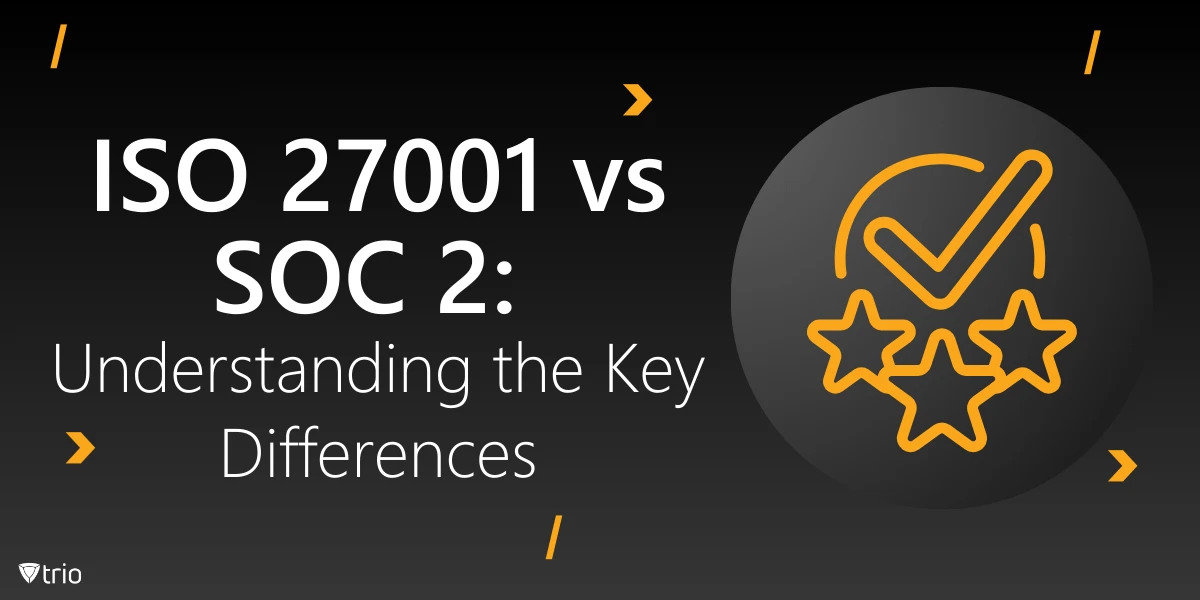If you’ve been dealing with data security, you’ve likely heard of ISO 27001 and SOC 2. These are two prominent security frameworks that organizations use to protect their information. Both play significant roles in setting up defenses against threats.
As an IT admin, understanding the differences between these compliance standards is necessary. Choosing the right one impacts your organization’s data security and overall IT compliance efforts. It’s all about finding the framework that aligns best with your needs.
In this blog, we’ll explore ISO 27001 vs SOC 2 to help you make an informed decision. By comparing SOC 2 vs ISO 27001, we’ll provide practical insights so you can select the framework that fits your organization’s goals.
What Is ISO 27001?
ISO 27001 is an international standard designed for information security management systems (ISMS). It provides a structured framework for companies to protect their sensitive data systematically. By implementing these security management systems (ISMS), businesses can proactively identify and manage security threats to ensure they meet the required types of compliance standards in the industry.
ISO 27001 is recognized worldwide and is a trusted standard for organizations of all sizes. The primary goal is to offer a comprehensive, risk-based approach to data protection. By focusing on identifying risks and minimizing potential damage, this framework helps businesses protect sensitive data effectively.
Achieving ISO 27001 certification involves a few critical steps. Companies need to establish a strong ISMS, conduct thorough risk assessments, and undergo continuous audits. A detailed audit report is necessary to ensure compliance, demonstrating the company’s ongoing commitment to information security.
What Is SOC 2?
Similar to ISO 27001, SOC 2 is a vital standard in data security. Developed by the American Institute of CPAs (AICPA), it outlines the SOC 2 criteria for managing data based on trust services principles. Grasping the SOC 2 certification meaning is crucial for organizations aiming for SOC 2 compliance.
SOC 2 makes sure your systems are operationally effective in processing user data. It emphasizes security, availability, processing integrity, confidentiality, and privacy. By focusing on processing integrity and confidentiality, organizations can mitigate risks and bolster trust.
There are two types of SOC reports: Type 1 and Type 2. Type 1 evaluates your controls at a specific moment, while Type 2 examines them over a period of time. These attestation reports provide insights into your compliance status. Understanding the difference between SOC 1 and SOC 2 is also important, as they focus on different aspects of data management.
ISO 27001 vs. SOC 2: Key Differences
Knowing these distinctions can help your organization decide which framework best aligns with its data security needs and operational goals.
Global vs. Regional Standards
ISO 27001 is a globally recognized standard that applies to companies worldwide, so it’s a preferred choice for international organizations looking to demonstrate compliance. On the other hand, SOC 2 is primarily used in the United States and is particularly relevant for service organizations that operate within or cater to the U.S. market.
SOC 2’s regional focus means it’s tailored for organizations handling customer data in the U.S. While ISO 27001 offers a consistent approach for businesses with global operations, SOC 2’s criteria are built around specific needs and regulations familiar to U.S.-based service organizations to help their systems align with local standards and client expectations.
ISO 27001 Certification vs. SOC 2 Attestation Audit
A crucial difference between these frameworks is their outcome. With ISO 27001, companies achieve a formal certification that signifies compliance with international standards. SOC 2, in contrast, provides an audit report following an independent auditor’s evaluation. This report highlights the effectiveness of implemented controls and compliance status.
This distinction is significant. While ISO 27001 focuses on continuous certification and surveillance, SOC 2’s audit report serves as an assurance tool, offering transparency to clients through detailed assessments rather than a standardized certification.

Approaches to Controls
ISO 27001 takes a structured, risk-based approach, setting specific control objectives that organizations must implement and monitor regularly. These controls are designed to be universally applicable, maintaining a consistent level of data protection across different environments.
SOC 2, on the other hand, is built around SOC 2 security controls. This makes it more flexible, allowing organizations to adapt controls based on their specific context. This adaptability helps service organization controls remain effective while addressing the unique challenges each organization faces in handling sensitive data.
Different Target Audiences
ISO 27001 is aimed at global businesses looking for a widely recognized certification to demonstrate their commitment to data protection. It’s ideal for multinational companies that want to standardize their information security practices across different regions and markets.
SOC 2, however, is geared toward service organizations that handle sensitive client data in the U.S. It’s commonly adopted by firms in industries like technology and finance that prioritize data security in client interactions. This makes SOC 2 a practical choice for companies wanting to build trust specifically within the U.S. market.
Choosing the Right Framework for Your Organization
Now that we’ve explored the specifics of each standard, let’s look at how to decide which is right for your business. Your choice depends on your operations, client expectations, and the level of data security you aim to achieve.

Business Model Consideration
If your organization operates globally or aims to showcase an internationally recognized compliance standard, ISO 27001 might be the better fit. It offers a consistent approach to data protection across regions, establishing a uniform level of security for sensitive data no matter where your business is based.
However, if you’re primarily a U.S.-based company dealing with user data, SOC 2 aligns with regional expectations and regulations. Its criteria are designed for service providers handling customer information in the United States, so it’s a practical choice when local compliance is key to your business model.
Customer and Market Expectations
Client demands play a big role in choosing the right framework. Customers may prefer ISO 27001 when they want assurance that their data is protected by a globally accepted standard. It helps build trust, especially if you work with international partners.
On the other hand, U.S. clients may expect SOC 2 compliance, particularly if they have faced or are worried about data breaches and security incidents. SOC 2’s focus on transparency and operational effectiveness can reassure customers that your controls are built to protect their information continuously.
Cost and Resources
Implementing ISO 27001 can be resource-intensive, requiring ongoing risk assessments and continuous management to maintain certification. The process might take significant time and investment but offers a robust, repeatable approach for global compliance.
SOC 2, while still demanding, may require fewer resources depending on the audit report type (Type 1 or Type 2). SOC 2 audits can be quicker to complete for organizations with well-established controls, allowing for flexibility in scaling compliance efforts based on available resources.
Implementing ISO 27001 and SOC 2 Together
For companies that operate globally or are expanding rapidly, combining ISO 27001 and SOC 2 can be a smart move. Integrating both standards allows organizations to build service organization controls that align with global expectations while also meeting U.S. compliance requirements, creating a comprehensive, unified approach to security management.
IT admins looking to align both frameworks should start by mapping out overlapping requirements to streamline implementation. This way, they can maximize efficiency, reduce redundancy, and build a cohesive security posture that addresses the needs of both international and U.S.-based clients. The result? A robust system that enhances trust and minimizes risk.
Trio: Enhancing Compliance With MDM Solutions
Both ISO 27001 and SOC 2 emphasize protecting sensitive data, and managing devices remotely ensures compliance with these standards. MDM solutions help enforce security policies, reducing the risk of data breaches and unauthorized access.
Our MDM product, Trio, aligns with these compliance frameworks by offering features for device management, compliance automation and data protection. It simplifies how you secure mobile devices, making adherence to ISO 27001 and SOC 2 smoother. Interested in enhancing your security posture? Try Trio with our free demo and see the difference it can make.
Conclusion: Making the Right Choice
Grasping the distinctions between ISO 27001 and SOC 2 is vital for organizations focused on enhancing data security and compliance. We’ve covered how each framework operates, their unique benefits, and the specific contexts in which they excel. This understanding equips you to make choices that align with your organization’s goals.
Recognizing these differences helps in making informed decisions tailored to your business model and client expectations. Whether it’s the global reach of ISO 27001 or the U.S.-centric focus of SOC 2, selecting the appropriate compliance standard can significantly impact how effectively you protect sensitive data and build trust with stakeholders.
Now is the time to assess your organization’s needs critically. Consider consulting with professionals to determine which framework, or combination of frameworks, best suits your situation. Taking steps today can strengthen your defense against data breaches and set your organization on a path toward robust data protection.
Know about news
in your inbox
Our newsletter is the perfect way to stay informed about the latest updates,
features, and news related to our mobile device management software.
Subscribe today to stay in the know and get the most out of your mobile
devices with our MDM solution app.
Recent Posts

Erase the Risk: Protect with Zero Standing Privileges
Learn how zero standing privileges eliminate persistent access rights, enhance data security and reduce the risk of unauthorized access.

Understanding Access Control Types in Cybersecurity w/ Examples
Thorough understanding of access control types & the knowledge to make informed decisions about implementing security measures in your organization.

Cloud Data Protection: Safeguarding Information in the Cloud
Learn essential strategies for robust cloud data protection, exploring tools, best practices, and policies that safeguard sensitive information.





